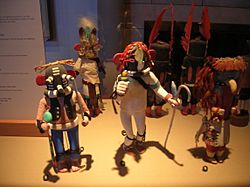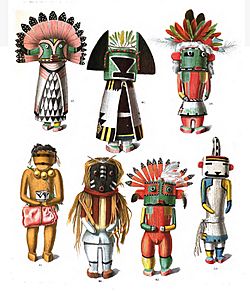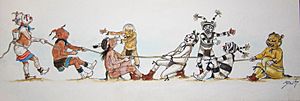Hopi Kachina figure facts for kids
Hopi katsina figures (Hopi language: tithu or katsintithu), also known as kachina dolls, are figures carved, typically from cottonwood root, by Hopi people to instruct young girls and new brides about katsinas or katsinam, the immortal beings that bring rain, control other aspects of the natural world and society, and act as messengers between humans and the spirit world.
Contents
Features
General features
There are four generally accepted forms of the kachina figures; each form is meant to represent a different stage of postnatal development.
- Putsqatihu – these figures are made specifically for infants; these are simply flat figures that contain enough characteristics of the kachina so it is identifiable.
- Putstihu taywa’yla – these figures have flat bodies and three-dimensional faces that are generally meant for toddlers.
- Muringputihu – these figures have cylindrical bodies, fully carved heads, and are meant specifically for infant girls.
- Tithu – the traditional, full-bodied kachina figures that is given to Hopi girls aged two and up at Hopi ceremonies. These figures represent the final stage of postnatal development.
In addition to these traditional forms, a modern variation is now being created: the miniature kachina figure. These are mostly created by Hopi women, are only produced for trade, and are not always considered to be kachina figures.
Facial features
There are two types of kachina figure eyes: painted eyes, which can be round, rectangular, pot-hooks, or half-moons, and pop eyes, which are carved of wood and then attached to the figures.
Additionally, there are two types of figure mouths. The first is the painted mouth, which can be either rectangular, triangular, or crescent shaped. The other is the carved mouth, of which there is either a horizontal mouth with a wide or narrow beard, a beak that is turned up or down, a tube or a short snout.
On the figure's head, there will be either bird wings, ears (typically large and red), cornhusk flowers, hair, feathers, or horns. The horns can either be pseudo-horns or real animal horn.
The noses are rarely realistic-looking, except when carved into the wood. Some kachinas also have beards of feathers or red-dyed horsehair.
Regalia
There are several common outfits on kachina figures. Typical male regalia includes:
- A white kilt, brocaded sash, belt, fox skin, and no shirt
- White shirt and kilt
- Kilt and ceremonial robe
- A "white man’s" suit
- Velvet shirt, white trousers, red leggings
- Fox skin hanging from belt
Common female regalia includes:
- Ceremonial robe worn as a dress and a shawl
- Manta
- Eagle feather skirt
- Black woolen dress, red belt, and a white shawl with red and blue bands
Kachina figures can also carry accessories that are associated with what their respective kachinam will carry during the ceremonial dances. Figures are portrayed with accessories including hand rattles made from gourds, bows and arrows, branches of Douglas fir, staffs, scissors, crooks with children, and colored corn. Sometimes the objects carried relate to the function of the Kachina; for example, Cold-Bringing Woman carries a sifter basket of snow and scatters it encouraging moisture in the form of snow for bountiful crops. Sometimes, to hide the space between the body and the mask, ruffs made of fox skin, juniper branches, Douglas fir, or cloth will be worn. In addition, headdresses are sometimes worn on the heads of the dolls. Common doll headdresses include maiden-whorls on the sides of the head, an eagle feather on the mask, or a tripod of sticks worn on top of the head.
Symbolism and color
Every symbol, color, and design on a Hopi kachina figure has definite meaning in connection with Hopi religion, custom, history, and way of life. Animal tracks, bird tracks, celestial symbols, and vegetable symbols represent those particular spirits. Other symbols and their meanings are as follows:
- A pair of vertical lines under the eyes symbolizes a warrior’s footprints.
- An inverted “V” signifies certain kachina officials.
Certain colors on the kachina figures also have significant directional meanings:
- Yellow = north or northwest
- Blue-green = west or southwest
- Red = south or southeast
- White = east or northeast
- All the colors together = Zenith (heaven) and above
- Black = Nadir (the underworld) or down
Determining authenticity
The first sign of a fake kachina doll is if it is "garish or crudely made." An authentic kachina figure will have proper proportioning of the body and no excessive detail. Hands must have separated fingers rather than tightly closed fists. Details in hair and accessories should be meticulously fashioned. The most valuable figures are made from a single piece of wood; signs of glue on the figure indicate a poorly-carved figure. The price will usually reflect the quality, so if a figure seems inexpensive, there is a good possibility it is not a true Hopi kachina figure.
Popular Katsina figure types
There are well over 200 types of kachina figures; however, almost no one can identify every single one, as each carver has a different idea as to the appearance and function of each Kachina. There are several popular ones with tourists and Hopi, however. Some of the more popular dolls are the Tasapkachina (Navajo Kachina), Angakchina (Long hair), Hote, and animal dolls such as Bear, Bird, and Mouse.
Clowns
Clowns also participate in the Hopi celebrations and sacred rituals. They have dual functions. Their most prominent role is to amuse the audience during the outdoor celebrations and Kachina Dances. They perform as jesters or circus clowns while the kachina dancers are taking a break between their performances. As a result of the spectator acceptance of the humor and variety of entertaining antics, clown carvings have been a favorite figure for sale to tourists and collectors. Carvers have found a strong market and challenge to create dolls showing the many whimsical clown actions. Their second and subtle role is in the sacred kachina rituals. The sacred functions of the clowns are relatively private, if not held secret by the Hopi, and as a result have received less public exposure. The Koshare (or Tewa clown) and the Koyemsi (Mud-head) are two of the most popular clown doll.
- Branson, Oscar, T. Hopi Indian Kachina Dolls. Tucson: Treasure Chest Publications, 1992.
- Bromberg, Eric. The Hopi Approach to the Art of Kachina Doll Carving. West Chester: Schiffer Publishing, 1986.
- Colton, Harold S. Hopi Kachina Dolls. Albuquerque: University of New Mexico Press. 1959.
- Earle, Edwin. Hopi Kachinas. New York: Museum of the American Indian Heye Foundation, 1971.
- Hunt, W. Ben. Kachina Dolls. Milwaukee: Milwaukee Public Museum, 1957.
- James, Harry C. The Hopi Indians, Their History and their Culture. Caldwell: Caxton Printers, 1956.
- Loftin, John D. Religion and the Hopi Life. Bloomington: Indiana University Press, 2003.
- McManis, Kent. A Guide to Hopi Kachina Dolls. Tucson: Rio Nuevo Publishers, 2000.
- Pecina, Ron and Pecina, Bob. Hopi Kachinas: History, Legends, and Art. Schiffer Publishing Ltd., . 2013.
- Teiwes, Helga. Kachina Dolls: The Art of Hopi Carvers. Tucson: University of Arizona Press, 1991.
- Wright, Barton. This is a Hopi Kachina. Flagstaff: The Museum of Northern Arizona, 1965.
Images for kids
-
Kachina Doll (Kokopol), probably late 19th century, Brooklyn Museum









